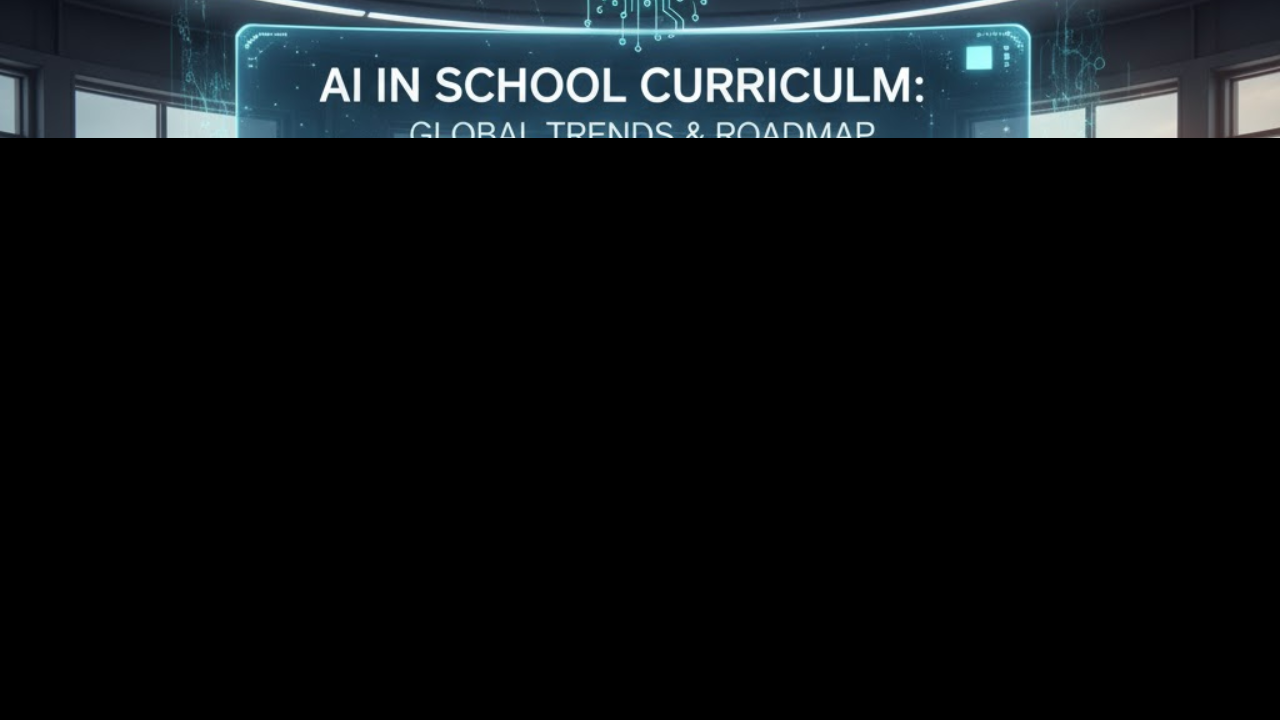
Post by : Naveen Mittal
Integrating AI in school curriculum has become a central agenda in educational reform worldwide. From India to the UAE and Israel, governments and educators are preparing students for an AI-driven future. As artificial intelligence becomes deeply embedded in every profession, teaching it from an early stage is no longer optional—it’s essential. This article explores the rise of AI in education, global initiatives, key curriculum components, benefits, challenges, and a roadmap for successful implementation.
The future workforce will depend on AI literacy, data interpretation, and problem-solving skills. Students of today will become professionals in industries where artificial intelligence will drive innovation—from healthcare and transport to design and marketing. Teaching AI early helps students understand its logic, capabilities, and limitations. It ensures they are creators and decision-makers in an AI-driven society, not passive consumers of automated systems.
AI tools can revolutionize how students learn by providing customized education plans. Intelligent tutoring systems, adaptive platforms, and data-driven assessments identify strengths and weaknesses in real time. This allows teachers to focus on deeper instruction while AI handles grading, attendance, and personalized feedback. AI in classrooms supports inclusivity by allowing students to learn at their own pace, regardless of their learning style or background.
Introducing artificial intelligence in school curriculum also has a social purpose. It can democratize access to technology and reduce the gap between urban and rural education systems. With proper resource allocation, AI education can reach every student, regardless of geography or income level. However, equal access to digital infrastructure remains crucial for achieving this vision.
AI education is not just about coding and algorithms—it nurtures creativity. When students build chatbots, robots, or data models, they learn design thinking, teamwork, and analytical reasoning. It sparks curiosity about how technology shapes society and encourages innovation through experimentation.
India has taken major steps in introducing AI in the school system. The central government plans to integrate AI from Class 3 starting in the 2026–27 academic year. The idea is to make artificial intelligence a foundational subject alongside mathematics and science. Several states have already begun pilot programs in both public and private schools.
Initiatives like “Skilling for AI Readiness” (SOAR) aim to introduce structured modules for students between grades 6 and 12. These short programs teach the basics of machine learning, data handling, and ethical AI. The CBSE board has also added AI as an elective subject in higher grades, allowing students to explore technical and ethical aspects in depth.
This phased approach ensures scalability, as India’s diverse educational landscape requires gradual implementation. Training teachers and updating school infrastructure are key priorities to make the AI curriculum effective nationwide.
The United Arab Emirates stands out as one of the first countries to make AI a mandatory part of its school curriculum. Starting from kindergarten to Grade 12, AI lessons cover everything from basic computing to complex machine learning concepts. Dubai’s education authorities believe that early exposure helps students develop a natural understanding of technology.
Over a thousand teachers are being trained to deliver the AI curriculum effectively. The focus extends beyond coding—it includes ethics, responsible AI use, and problem-solving. Even young learners engage with AI-based games, robotics, and augmented reality experiences that make learning interactive and fun.
This comprehensive approach reflects the UAE’s national strategy to become a global AI leader. It also aims to prepare a generation of students who can contribute to the knowledge economy of the future.
Israel has long emphasized technology-driven education, and its AI integration strategy builds on this foundation. While large-scale implementation in K–12 schools is still developing, the focus has been on teacher training, curriculum research, and partnerships with universities. Educational institutions are aligning AI literacy with ethics, social impact, and innovation—ensuring students learn both the technology and its implications for society.
Globally, several other countries are following similar paths. Nations like Singapore, Finland, and the United States are embedding AI modules in STEM curricula, promoting critical thinking and ethical responsibility in technology use.
AI education must be tailored to developmental stages. For young learners in early grades, the curriculum should focus on logic, pattern recognition, and curiosity-driven activities. Middle school students can begin working with simple AI projects such as image recognition or basic data tasks. High school students should move into more advanced machine learning topics and ethics discussions, linking AI concepts to real-world challenges.
Countries are experimenting with two models—teaching AI as a separate subject or embedding it across subjects like science, mathematics, and social studies. The most effective strategy combines both. Dedicated AI lessons ensure depth, while integration across disciplines fosters practical application.
A curriculum is only as strong as its educators. Teachers need specialized training in AI literacy, pedagogy, and ethics. Professional development programs should include both theoretical learning and hands-on projects. Building communities of practice where teachers exchange ideas and resources ensures continuous improvement.
To teach AI effectively, schools need reliable internet access, computers, AI software, and access to open datasets. Low-code or no-code AI tools can simplify learning for beginners. Governments must prioritize funding for these resources to avoid leaving underprivileged schools behind.
Teaching AI without discussing ethics can be dangerous. Students must understand the consequences of bias in algorithms, privacy breaches, and misuse of AI. Classroom discussions about real-life examples encourage critical thinking about responsible AI development.
AI curriculum assessment should move beyond traditional exams. Project-based evaluations allow students to demonstrate creativity and problem-solving skills. Building AI models, writing reflective journals, or presenting group projects gives a more accurate picture of learning outcomes.
AI education prepares students for future jobs that demand critical thinking, data literacy, and adaptability. It builds problem-solving skills and computational logic—competencies essential for every profession.
AI tools personalize education by adjusting to each learner’s pace and preferences. This ensures better engagement, retention, and academic performance. Teachers can use AI analytics to identify struggling students early and provide targeted support.
Automation of administrative work like attendance and grading gives teachers more time to focus on interaction, creativity, and emotional support. AI also provides insights into classroom dynamics and helps in creating more inclusive learning environments.
When students use AI to create projects—such as robots, chatbots, or environmental monitoring apps—they develop design thinking, leadership, and collaboration skills. These experiences transform them into innovators rather than passive learners.
If implemented fairly, AI curriculum can reduce disparities between well-funded and under-resourced schools. Shared online resources and centralized AI tools can make quality education accessible to everyone.
Despite its promise, introducing AI in education faces obstacles.
Infrastructure Limitations: Many schools still lack computers, internet connectivity, or digital learning platforms.
Teacher Preparedness: Teachers may not have adequate training or confidence to teach AI concepts effectively.
Curriculum Overload: Adding AI lessons to already packed schedules can overwhelm both teachers and students.
Data Privacy Concerns: Using AI tools in classrooms raises concerns about student data security and misuse.
Equity Issues: Wealthier schools often implement AI programs faster, widening the gap between social groups.
Rapid Technological Changes: AI evolves faster than curricula can be updated, making continuous adaptation necessary.
Governments must address these challenges with proper planning, funding, and policy reforms.
The first step is to define clear goals. Authorities must outline what AI education aims to achieve—whether it’s basic literacy or advanced technical proficiency. Stakeholder consultations with educators, industry experts, and policymakers ensure realistic planning.
Develop modular content that progresses from foundational knowledge to advanced understanding. Localize the curriculum to cultural and linguistic contexts. Include both theory and application through real-world projects.
Continuous professional development must be mandatory. Workshops, online certifications, and mentorship programs can build teacher confidence. Educators should also be encouraged to participate in co-designing AI lessons to ensure practicality.
Investing in digital infrastructure is non-negotiable. Schools need computers, reliable networks, and AI-based educational platforms. Government and private sector partnerships can help resource-strapped schools.
Begin with small-scale pilots before nationwide implementation. Monitor student engagement, teacher performance, and learning outcomes. Gather feedback and refine the curriculum accordingly.
After successful pilots, expand the program gradually. Ensure annual reviews to update content with the latest AI advancements. Encourage collaboration between education ministries, universities, and technology firms to maintain relevance.
Introduce AI topics through simple, interactive activities like games and puzzles.
Encourage project-based learning where students solve real-world problems.
Use visual and intuitive AI tools suitable for young learners.
Connect AI to daily life—traffic lights, online recommendations, or smart devices—to make lessons relatable.
Organize AI exhibitions, hackathons, and student competitions to foster interest.
Promote discussions on ethics, privacy, and responsible AI use.
Include parents and communities in awareness programs to ensure long-term support.
India’s approach focuses on long-term integration. The AI curriculum will start small, evolve through pilot programs, and eventually become a standard part of the national education system. This gradual strategy allows time for infrastructure development, teacher readiness, and public awareness.
The UAE, on the other hand, has taken a bold step by implementing AI education across all grade levels simultaneously. This reflects the country’s vision to lead the region in technological education. Teacher training, ethical AI, and real-world applications are prioritized to ensure balanced learning outcomes.
Both models have merits—India’s phased rollout ensures inclusivity, while the UAE’s rapid approach accelerates national skill development. Other nations can learn valuable lessons from both.
The integration of AI in school curriculum marks a transformative era in education. It equips students with the skills needed for the 21st century—critical thinking, creativity, and technological literacy. However, success depends on thoughtful implementation, continuous teacher training, and equitable resource distribution.
Countries like India and the UAE are setting global examples by embedding AI education into their national strategies. As AI continues to shape the future of work and society, schools play a vital role in preparing the next generation not just to use AI—but to lead it.

Numou Launches Procurement Financing to Support SMEs in Abu Dhabi
The new Procurement Financing by Numou aids UAE SMEs in overcoming cash flow hurdles, enhancing acce

Elon Musk Envisions a Future Where AI Takes Over All Jobs, Liberating Humanity
Elon Musk predicts that AI and robots will supplant jobs, granting people freedom and a universal in

Djokovic Opts Out of 2025 Paris Masters Tournament
Novak Djokovic revealed he'll miss the 2025 Paris Masters, reminiscing about past victories without

AT&T Exceeds Subscriber Expectations with iPhone 17 Campaign
In Q3, AT&T gains 405K wireless subscribers via iPhone 17 promotions, despite a slight revenue short

Mboko Shines Brightly to Reach Tokyo Quarter-Finals
In under an hour, 19-year-old Mboko secures her place in the Tokyo Quarter-Finals, showcasing precis

U.S. Economic Growth Surges Amid Uncertainty Over Data
The U.S. GDP has risen by 3.9% in Q3, yet concerns about a government shutdown and labor market issu

Zimbabwe Celebrates Historic Test Triumph Over Afghanistan
Zimbabwe marked its first home Test win in a decade, dominating Afghanistan by an innings and 73 run

Mboko Shines Brightly to Reach Tokyo Quarter-Finals
In under an hour, 19-year-old Mboko secures her place in the Tokyo Quarter-Finals, showcasing precis

Zimbabwe Celebrates Historic Test Triumph Over Afghanistan
Zimbabwe marked its first home Test win in a decade, dominating Afghanistan by an innings and 73 run

Dodgers Reveal Pitching Lineup for World Series Clash with Blue Jays
Dodgers' manager Dave Roberts has revealed the World Series starters, with Blake Snell taking Game 1

Warriors Defeat Lakers; Thunder Triumph in Epic Triple Overtime
Warriors claim victory over Lakers 119-109; Thunder win an intense triple OT thriller against Rocket

Mumbai Singer Actor Rishabh Tandon Dies Suddenly at 35
Mumbai’s singer actor Rishabh Tandon dies at 35 after a sudden heart attack in Delhi leaving fans an

Renshaw Prioritizes Personal Growth Over Ashes Buzz
Matt Renshaw emphasizes self-improvement over Ashes discussions as he aims for a Test comeback.

Arctic Athleisure Stylish Performance Wear for Urban Winters
Discover Arctic Athleisure where high performance fabrics meet urban style for warm comfortable and

Ponting Stands Firm on Kohli and Rohit Following ODI Setback
Ricky Ponting insists Virat Kohli and Rohit Sharma are still key players for India despite a recent